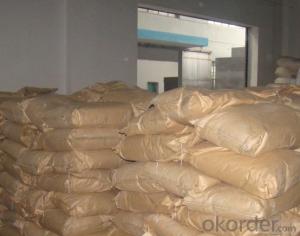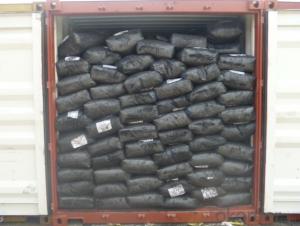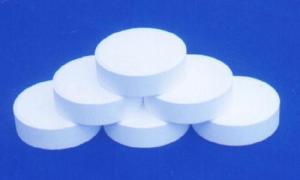RUBBER VULCANIZING ACCELERATOR CHEMICALS CZ
- Loading Port:
- Tianjin
- Payment Terms:
- TT OR LC
- Min Order Qty:
- 25 m.t.
- Supply Capability:
- 12000 m.t./month
OKorder Service Pledge
OKorder Financial Service
You Might Also Like
RUBBER VULCANIZING ACCELERATOR CBS(CZ)
Chemical Name: N-Cyclohexyl-2-benzothiazole sulfenamide
Molecular Formula: C13H16N2S2
Molecular Weight: 264.4
CAS NO. : 95-33-0
Executive standard:HG/T 2096-2006
Specification:
| Index | ||
High-class products | First-class products | Acceptable end-product | |
Appearance |
| ||
Initial M.P,oC ≥ | 99.0 | 98.0 | 97.0 |
Loss on drying,% ≤ | 0.20 | 0.30 | 0.50 |
Ash, % ≤ | 0.20 | 0.30 | 0.40 |
Residue,% ≤ | 0.00 | 0.05 | 0.10 |
In soluble in Methanol,% ≤ | 0.50 | 0.50 | 0.80 |
Purity,% ≥ | 97.0 | 96.0 | |
Free amine,% ≤ | 0.50 | ||
Properties: Gray, light yellow powder or granules with a little odor, no poison. The density is 1.31-1.34. And melting point 90-108 oC .Soluble benzene, methylene chloride, carbon tetrachloride, ethyl acetate, acetone, ethanol-soluble and petrol do not dissolve in water.
Application: to promote common aftereffect on sexual one. Furnace applicable to the use of black plastic material, both anti-burning performance and excellent short curing time two major advantages. Enable for natural rubber, recycled rubber, vinyl synthetic rubber, especially for the SBR. May be used alone, but also with promoting agent D, DT, TT, TS and others use. Because of a bitter, it can not be used for food-related products. Photochromic minor, do not emit cream vulcanizate excellent anti-aging properties. Used tires, shoes, hose and belt, cable, general industrial products.
Packaging: 25kg plastic woven bag, paper with plastic film bag, Kraft paper bag or jumbo bag.
Storage: The product should be stored in the dry and cooling place with good ventilation, avoiding exposure of the packaged product to direct sunlight. The validity is 1 year.
Note: The product could be ultra fine powder based on customer accurate requirement.
- Q: Hydrogen and oxygen in the role of the catalyst can do the chemical formula of aviation fuel?
- 2H2 + O2 = catalyst = 2H2O
- Q: What is the similarity between enzymes and general chemical catalysts?
- (1) The enzyme is the same in many respects as a biocatalyst and a general catalyst, such as a small amount and a high catalytic efficiency. As with the general catalyst, the enzyme can only change the rate of chemical reaction and does not change the equilibrium of the chemical reaction It is possible to catalyze the activation of a large number of substrates in a short time and to reflect the high efficiency of enzyme catalysis.The enzyme can reduce the activation energy of the reaction (activation) (△ G) during the reaction, but the reaction rate is accelerated and the reaction time is reduced, but the equilibrium constant is not changed. (2) However, the enzyme is a biological macromolecule (1) Enzyme-catalyzed high efficiency: The catalytic effect of the catalyst can increase the reaction rate by 10 ^ 6 ~ 10 ^ 12 times, which is at least several times higher than that of the conventional catalyst. (2) The enzyme catalyst Highly specificity: including specificity of response, substrate specificity, chirality specificity, geometric specificity, etc., that an enzyme can only act on a certain class or a specific substance. Bond, ester bond, peptide bond and so on can be catalyzed by acid-base hydrolysis, but the hydrolysis of these chemical bonds are different, respectively, the corresponding glycosidase, esterase and peptidase, that is, they were specific (3) enzymatic reaction conditions are mild: enzymatic reaction is generally carried out in aqueous solution of pH = 5 ~ 8, the reaction temperature range is 20 ~ 40 ℃
- Q: What about the chemical reaction of the catalyst if there is no catalyst?
- Slow response or no reaction
- Q: What is the difference between electrocatalysis and general chemical catalysis?
- General chemical catalysis is a catalyst, and electrocatalysis also need to be carried out under the conditions of the electric field
- Q: What are the requirements for the catalyst for the chemical industry?
- Generally find a few, according to the cost and cost of cost, choose cost-effective
- Q: Explain how catalysts help to reduce costs in industrial processes !?Thanks
- They speed up a reaction, allowing you to get more product more quickly and remain unchanged, therefore you can use them over and over again.
- Q: Which chemical reaction is added to the catalyst in order to slow down the reaction
- CaC2 and water reaction to ethylene plus salt water (slow chemical reaction rate)
- Q: Chemical reaction plus catalyst on the △ H no effect
- The catalyst only affects the reaction rate of the substance and increases its activation energy, and the enthalpy change is only related to the initial state of the substance, independent of the reaction process.
- Q: Is the enzyme in the enzyme bigger than gold?
- A biological enzyme is equivalent to a key that opens a complex compound whose importance is that its unique structure or multidimensional shape matches a part of the group. Once these two parts are combined, the specific chemical bond in the group molecule changes as if the lock was opened. When the reaction is completed, the enzyme is released and repeated with the next group, followed by repeated repeats. Many chemical reactions in the normal temperature conditions, the reaction is very slow so that the whole process is difficult to be perceived.
- Q: Can you describe at least 4 ways a catalyst can lower the activation energy of a reaction?
- To see how a catalyst accelerates the reaction, we need to look at the potential energy diagram shown below which compares the non-catalytic and the catalytic reaction. For the non-catalytic reaction, the figure is simply the familiar way to visualize the Arrhenius equation: the reaction proceeds when A and B collide with succificient energy to overcome the activation barrier. The change in Gibbs free energy between reactants, A + B, and the product P is delta G. The catalytic reaction starts by bonding of the reactants A and B to the catalyst, in a spontaneous reaction. Hence, the formation of this complex is exothermic and the free energy is lowered. There then follows the reaction between A and B while they are bound to the catalyst. This step is associated with an activation energy; however, it is significantly lower than that for the uncatalyzed reaction. Finally, the product P seperates from the catalyst in an endothermic step. The energy diagram illustrates 4 ways the catalyst works : The catalyst offers an alternative path for the reaction that is energetically more favorable The activation energy of the catalytic reaction is significantly smaller than that of the uncatalyzed reaction; hence the rate of the catalytic reaction is much larger The overall change in free energy for the catalytic reaction equals that of the uncatalyzed reaction. Hence, the catalyst does not affect the equilibrium constant for the overall reaction. A catalyst cannot change the thermodynamics of a reaction but it can change the kinetics. The catalyst accelerates both the forward and the reverse reaction to the same extent. In other words, if a catalyst accelerates the formation of product P from A and B, it will do the same for the decomposition of P into A and B.
Send your message to us
RUBBER VULCANIZING ACCELERATOR CHEMICALS CZ
- Loading Port:
- Tianjin
- Payment Terms:
- TT OR LC
- Min Order Qty:
- 25 m.t.
- Supply Capability:
- 12000 m.t./month
OKorder Service Pledge
OKorder Financial Service
Similar products
Hot products
Hot Searches
Related keywords

































